|
|
|
Sort Order |
|
|
|
Items / Page
|
|
|
|
|
|
|
| Srl | Item |
| 1 |
ID:
074632
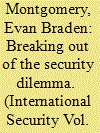

|
|
|
|
|
| Publication |
2006.
|
| Summary/Abstract |
In the debate between offensive and defensive realism, a central issue is whether major powers can overcome the uncertainty that drives the security dilemma. Whereas offensive realists maintain that states cannot know others' motives and intentions, defensive realists argue that states can reveal their preferences by altering their military posture. Defensive realists have, however, presented an incomplete account of the constraints and opportunities associated with military reassurance. To demonstrate its motives, a security-seeking state must take actions that will often increase its vulnerability to potential aggressors. Although offense-defense variables have been invoked to address the constraint of vulnerability, the conditions usually considered most favorable for reassurance-differentiation between offense and defense and an advantage for the latter-make it no easier to achieve. A defensive advantage makes reassurance difªcult by encouraging all states to adopt defensive capabilities and by requiring large concessions to reveal benign motives. Only when offense and defense are differentiated and the balance between them is neutral can states reveal their motives without also endangering their security. These arguments are illustrated with three empirical examples: the Anglo-German naval race, Nikita Khrushchev's troop cuts, and Mikhail Gorbachev's arms limitation and arms control policies.
|
|
|
|
|
|
|
|
|
|
|
|
|
|
|
|
| 2 |
ID:
120286
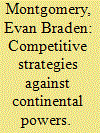

|
|
|
|
|
| Publication |
2013.
|
| Summary/Abstract |
This article makes three arguments about the Sino-American competition, the Sino-Indian rivalry, and the US-India partnership. First, past maritime-continental rivalries suggest that China will pose a greater challenge to American interests as it confronts fewer threats on land, while the US may require continental allies to counter-balance China's rise. Second, whereas a Sino-Indian continental security dilemma could benefit the US by compelling China to invest in capabilities that do not threaten it, a Sino-Indian maritime security dilemma could have the opposite effect. Third, Washington should consider India as a prospective continental ally rather than a potential maritime partner.
|
|
|
|
|
|
|
|
|
|
|
|
|
|
|
|
| 3 |
ID:
131114
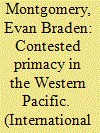

|
|
|
|
|
| Publication |
2014.
|
| Summary/Abstract |
Despite their disagreements, proponents of deep engagement and offshore balancing share an optimistic but unrealistic assessment of U.S. military power. In particular, both sides in the debate over U.S. grand strategy underestimate the potential consequences of China's military modernization. China's antiaccess/area denial strategy and conventional precision-strike capabilities are already undermining the United States' ability to prevent local conflicts, protect longtime allies, and preserve freedom of the commons in East Asia. Whether the United States intends to uphold the status quo when threats emerge or adopt a wait-and-see approach to regional conflicts, it will need to adapt its military for power projection operations in much less permissive environments than it has become accustomed to during the unipolar era. These adaptations include developing air and undersea platforms that can survive inside denial zones, forward bases that are better able to withstand attacks, and satellite and cyberspace networks that are less vulnerable to disruption.
|
|
|
|
|
|
|
|
|
|
|
|
|
|
|
|
| 4 |
ID:
120171
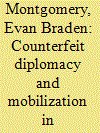

|
|
|
|
|
| Publication |
2013.
|
| Summary/Abstract |
How do policymakers in democratic nations mobilize support for hard-line strategies? Existing answers to this question emphasize the exaggeration of external threats. Yet this overlooks an important dilemma: because democratic citizens expect their leaders to explore peaceful solutions or less aggressive alternatives when foreign dangers are ambiguous, the same conditions that make threat inflation necessary also make it difficult to employ successfully. To mobilize support for hard-line measures when the public wants its leaders to demonstrate restraint, policymakers may therefore attempt to shift blame onto an adversary by using "counterfeit diplomacy." Specifically, democratic leaders may adopt more cooperative or less coercive options than they believe are necessary, but which they anticipate will fail. This approach can be a risky one, however, because an opponent might accept a nation's demands, accede to its conditions, or offer counterproposals in the hope of diffusing support for more confrontational measures.
|
|
|
|
|
|
|
|
|
|
|
|
|
|
|
|
| 5 |
ID:
100571


|
|
|
|
|
| Publication |
2011.
|
| Summary/Abstract |
Iran's acquisition of a nuclear bomb would upend the Middle East. It is unclear how a nuclear-armed Iran would weigh the costs, benefits, and risks of brinkmanship, meaning that it could be difficult to deter Tehran from attacking the United States' interests or partners in the region.
|
|
|
|
|
|
|
|
|
|
|
|
|
|
|
|
| 6 |
ID:
098792
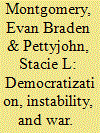

|
|
|
|
|
| Publication |
2010.
|
| Summary/Abstract |
In 2006 Israel resumed military operations in the Gaza Strip and conducted a war in Lebanon following attacks by Hamas and Hezbollah, respectively. Due to the elections that had recently taken place in the Palestinian territories and Lebanon, these events seem to support the argument that democratizing nations are particularly war-prone. Yet the dynamics this perspective identifies as dangerous were largely absent. To address this puzzle, this paper offers three arguments. First, democratization enhanced the power of groups openly hostile to Israel, increasing Israel's perception of threat. Second, democratization was threatening because it occurred within highly divided societies governed by weak state institutions that allowed radical groups to attain political power. Finally, Israel's response to the increased threat posed by these groups was ultimately counterproductive because it further eroded the capacity of the Palestinian and Lebanese governments, heightened polarization within both societies, and therefore exacerbated the same conditions that made democratization threatening to begin with.
|
|
|
|
|
|
|
|
|
|
|
|
|
|
|
|
| 7 |
ID:
173662


|
|
|
|
|
| Summary/Abstract |
Policymakers should not fool themselves into thinking that there are easy, lowcost alternatives to keeping the threat of opportunistic aggression at bay.
|
|
|
|
|
|
|
|
|
|
|
|
|
|
|
|
| 8 |
ID:
188256
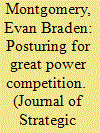

|
|
|
|
|
| Summary/Abstract |
The United States has adjusted its nuclear posture recently by adding nonstrategic weapons to its arsenal and raising the prospect of nuclear retaliation for nonnuclear attacks against command-and-control systems. Critics argue the former change is too dangerous due to the discrimination problem, while the latter change is too draconian due to the proportionality problem. I argue instead that new capabilities introduce a magazine depth problem, while new threats introduce an opportunistic aggression problem. This suggests that changes in force structure are not as dangerous as critics suggest, while changes in declaratory policy are more dangerous than they realize.
|
|
|
|
|
|
|
|
|
|
|
|
|
|
|
|
| 9 |
ID:
175515
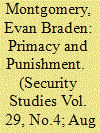

|
|
|
|
|
| Summary/Abstract |
Perhaps the most significant foreign policy decision facing the United States is whether to retain its global security commitments or retrench from key regions. Although primacists are optimistic that the United States will remain ahead of its rivals, restrainers are more pessimistic about its prospects. I argue instead that this debate overlooks the importance of geopolitical orientation. Maritime powers such as the United States are frequently in competition with multiple adversaries at once. This introduces an interdependent commitment problem that makes primacy difficult to sustain and dangerous to enforce, especially given the propensity to employ similar military approaches against different opponents. At the same time, maritime powers experiencing decline can respond in ways that fall short of retrenchment. This is mainly because their naval forces provide many options for upholding their obligations. Applied to the United States, these arguments suggest Washington might choose to diversify its defense strategy rather than abandon its commitments. In the Middle East, for example, it could rely on punishment via naval blockade rather than denial against Iran, not only because the former strategy would require fewer high-value military assets than the latter but also because it might allow the United States to avoid the types of clashes that would undermine its position relative to higher-priority threats.
|
|
|
|
|
|
|
|
|
|
|
|
|
|
|
|
| 10 |
ID:
190364
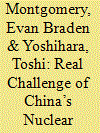

|
|
|
|
|
| Summary/Abstract |
For more than a decade, China’s military modernization has cast a shadow across the Indo-Pacific. For instance, the People’s Liberation Army (PLA) has fielded a variety of missiles and aircraft that have heightened the vulnerability of the United States, its allies, and its partners to conventional precision strikes. Moreover, an expanding fleet of surface vessels, amphibious platforms, and submarines could eventually provide Beijing with the ability to seize territory it covets and sustain military operations far beyond its neighborhood. These and other investments have not only raised questions about Washington’s ability to deter the use of force against frontline states, but also created doubts whether the United States could defeat an assault if deterrence were to fail.Footnote
|
|
|
|
|
|
|
|
|
|
|
|
|
|
|
|
| 11 |
ID:
122930
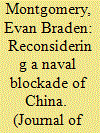

|
|
|
|
|
| Publication |
2013.
|
| Summary/Abstract |
Sean Mirski's assessment of a naval blockade is an important contribution to the debate over how the United States should respond to China's growing military power. Nevertheless, it has three limitations. First, although distant and close-in blockades could be employed in tandem, analyzing them separately helps to explain when they might be used and how they could influence escalation. Second, while conventional countervalue and counterforce options could also be employed together, this would depend on the degree to which they overlapped and the order in which they were implemented. Third, a blockade could lead to unanticipated prewar, intra-war, and postwar challenges.
|
|
|
|
|
|
|
|
|
|
|
|
|
|
|
|
| 12 |
ID:
137246
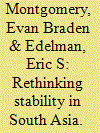

|
|
|
|
|
| Summary/Abstract |
India and Pakistan are currently engaged in a competition for escalation dominance. While New Delhi is preparing for a limited conventional campaign against Pakistan, Islamabad is pursuing limited nuclear options to deter India. Together, these trends could increase the likelihood of nuclear conflict. India, for example, might conclude that it can launch an invasion without provoking a nuclear reprisal, while Pakistan might believe that it can employ nuclear weapons without triggering a nuclear exchange. Even if war can be avoided, these trends could eventually compel India to develop its own limited nuclear options in an effort to enhance deterrence and gain coercive leverage over Pakistan.
|
|
|
|
|
|
|
|
|
|
|
|
|
|
|
|
| 13 |
ID:
173810
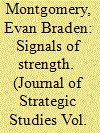

|
|
|
|
|
| Summary/Abstract |
States often use demonstrations to improve perceptions of their military power. This topic has received limited attention in the literature, which typically assumes that states disguise or downplay their capabilities, advertise them only to enhance their prestige, or use demonstrations to communicate interests and resolve. Because military strength can be difficult to gauge, however, successful deterrence and assurance can require demonstrations to ensure that capabilities are viewed as credible. This article explains the logic of capability demonstrations, identifies the conditions under which they have the most utility, introduces a typology of demonstration mechanisms, and describes how emerging technology influences demonstrations.
|
|
|
|
|
|
|
|
|
|
|
|
|
|
|
|
|
|
|
|
|